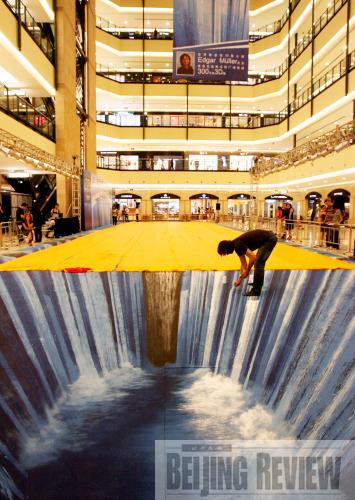|
 |
|
IS IT REAL? Famous 3-D artist Edgar Muller makes final embellishments to his large 3-D painting, which was placed in the Meilong Town Square in Shanghai on August 5 (LIU YING) |
A digital, interactive display of 61 famous figures breathed life into classical art works during the World Classic Interactive Arts Exhibition, which opened in Beijing on August 15 for a three-month engagement.
"I got married at 16," says the smiling Mona Lisa, made famous in Leonardo Da Vinci's famous painting. She breaks her unperturbed silence to wave to the audience and answers their questions. Not far from her, Jesus, Judas and other figures from The Last Supper are all brought back to life. Michelangelo, the famous Italian Renaissance painter, sculptor and architect, introduces his techniques to the audience with different gestures.
Thanks to 3-D technology, holographic images and voice recognition technologies, the figures can speak and move. It is the first time the advanced technologies have been fused together in one exhibition, which gives audiences the opportunity to experience the marvels of cutting-edge technology.
Three-dimensional, or 3-D, technology creates visual illusions and enables people to see images in the round that are actually only two-dimensional.
The technology is an important transformation in the digital field, paving the way to restoring real images and promoting development of the industry. Industrial chains for the advanced technology have been built for the large-scale growth of 3-D-related sectors, including content creation, displays, processing chips, software and consumer terminals. Although 3-D technology is a difficult scientific concept, it is already being widely used in people's daily lives. With the development of new three-dimensional digital technologies including 3-D images and pictures, digital audio and video, virtual reality, emulation and the 3-D Internet, the technology has been radically changing people's ways of communicating and working.
Digital cameras that record in 3-D have been brought to market. Different from traditional digital cameras, 3-D cameras have two lenses like human eyes that overlay the same shot to produce a 3-D image. There are two CCD sensors inside the cameras, which can also function as normal cameras.
Manufacturers have also launched 3-D developing and printing and 3-D digital photo frames, which can broadcast 3-D photos. Processing software allows flat photos in the frame to achieve 3-D visual effects that can be seen by users without wearing special glasses.
The long-anticipated 3-D display has also been launched. Many current games are 3-D motion pictures that can only achieve their intended effect by being equipped with 3-D displays glasses. When a display presents pictures for the left eye, the left lens is transparent to light while the right lens is opaque. It is the opposite when the display outputs for the right eye. As a result, the two eyes see different pictures that together form 3-D pictures to the brain. The shutter speeds of 3-D displays and glasses can rise above 60 Hz, otherwise the brain interprets it as the blinking of the eye. Display refresh rates should be at least 120 Hz to ensure that the shutters before each eye can reach 60 Hz. The ultimate goal of display manufacturers is to mimic the naked eye's ability to create the 3-D effect.
After nine years of research, Suzhou Snail Electronic Co. Ltd., China's first 3-D cyber games developer, took the lead to establish a 3-D Internet marketing platform. "The first virtual business" is aimed at transforming Internet marketing with its newly developed Web 3-D technology, which solves a series of thorny problems in Internet 3-D applications. By embedding virtual scenes, the technology lowers the requirements for the Internet and hardware so as to enable Internet users to experience fast 3-D effects. Enterprises can build highly realistic online virtual experience centers.
The 3-D experience Internet marketing includes various marketing exhibitions and data collection and analysis. By using the first virtual business to experience 3-D displays of virtual figures, scenes and products on marketing platforms, Internet users can get information on brands and products. They can also go shopping in a 3-D environment just like in the real world by selecting goods, checking reviews and trying out recommended goods. Meanwhile, sales can be more active and effective when sale consultants, after analyzing consumer behavior, recommend their favorite goods. Consultants can also raise topics related to products to form collective discussions. All these marketing methods help to develop consumers' impressions and dependence on merchants so as to influence consumers' desires and habits.
On August 1, Seven Days, a well-known apparel company and the Suzhou Snail Electronic jointly launched an online shop powered by Web 3-D technology. "As the first apparel company cooperating with a 3-D technology company, the sale of our company is expected to reach 15 percent," said Zhang Longjiang, Chairman of Shaoxing Sintalon Textile Co. Ltd, who owns the brand of Seven Days.
Web 3-D technology will be used in more fields. According to He Yixi, Vice General Manager of Suzhou Snail Electronic, apart from the apparel company, enterprises in various sectors, such as automobiles and travel, have adopted the first virtual business solution.
In virtual traveling, tourists can enjoy emulated scenic spots, monuments and sites and all legends and information related to them. They also can talk to guides and other tourists, who are represented as 3-D virtual figures. Management personnel of these scenic spots can recommend travel options and promote traveling programs.
In Suzhou, where the headquarters of Snail Electronic Co. Ltd. is located, the first online 3-D police station in the world has been established. It has eight functions including various online businesses, consultancy, downloads, reservations, public services, warning tips and communication between the police and the public. The station, maintained by four people, serves as a platform for police officials to provide professional and timely online service for residents from 9 a.m. to 9 p.m. During the rest of time, a robot in the station serves residents. |
